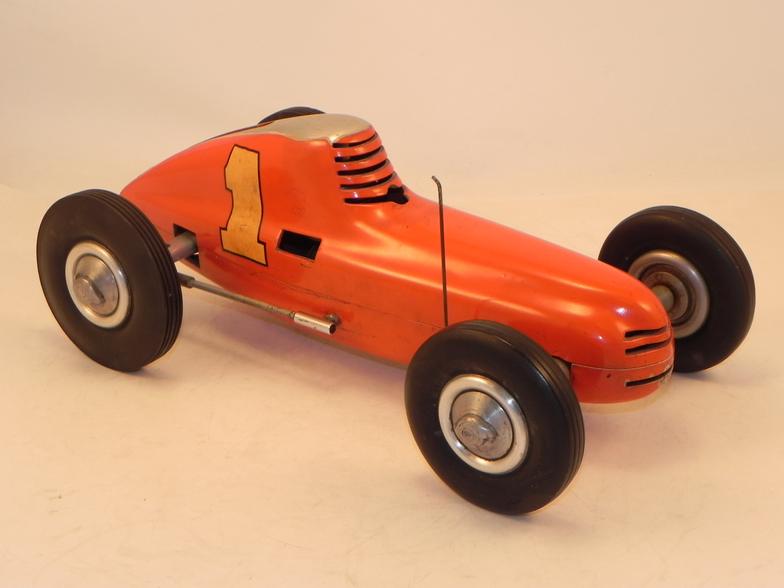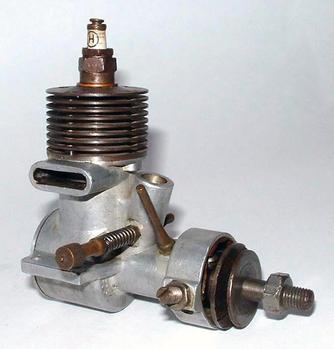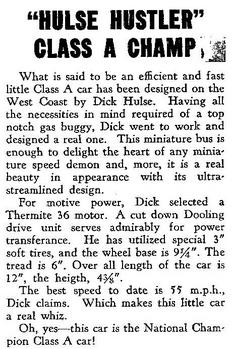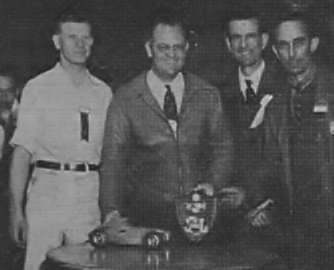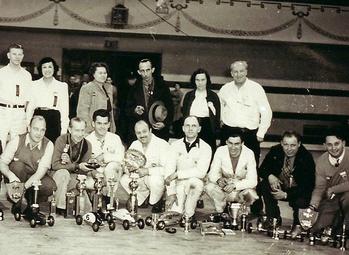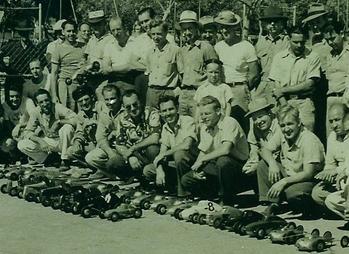mitecars.com
email: [email protected]
In the Beginning... Part 4. Dick Hulse's Influence on Mite Cars
The two gentlemen who are generally credited with leading the successful effort to establish the American Miniature Racing Car Association, Dick Hulse and Charles Penn, were both strong proponents of the smaller Class A cars (i.e. race cars with engine displacements of less than .36 cubic inches). But, their reasons for doing so were totally different, probably because of their differing backgrounds. And the manner in which they demonstrated their support for the smaller size cars differed greatly from one another.
Charles Penn was a New Yorker and was the publisher of Model Craftsman magazine. He was not a hobbyist and he had no interest in actually building and racing gas powered miniature race cars. His motivation for promoting the miniature car racing hobby was purely financial: by spurring interest in this fledgling hobby, he hoped to increase the number of subscribers to his magazine and generate additional ad revenue from race car and model engine manufacturers and distributors.
Dick Hulse, however, was a hobbyist who simply wanted to help grow the hobby which he enjoyed. Hulse was a successful real estate agent from Fresno, CA and his introduction to tether car racing came in September 1937 when he happened to be a spectator at the first organized gas powered miniature car race held at the Los Angeles model airplane flying field. But it wasn’t until several months later that Hulse actually purchased a race car and began competing with other Fresno-area racers. Hulse’s car was fast, due in part to the fact that Ray Snow helped build it, and Hulse soon became recognized on the West Coast as one of the “hot shoes” in tether car racing.
But Hulse’s efforts to support the growing hobby were not limited to his performance on the track. He and a small group of other Fresno-area racers formed the Model Midget Association of Fresno and Hulse was elected president of the club. He also led the effort to build Fresno’s first tether car track on a ranch owned by one of the members of the Fresno club. That early dirt track was soon replaced by a much smoother, and less dusty, track with an asphalt surface. But the asphalt surface soon proved to be unsatisfactory, and that track was subsequently replaced with the finest tether car track in the state: a 1/16th mile concrete track with lights so that races could be held in the evening.
Taking advantage of the new track and the speeds which cars were reaching on its concrete surface, Hulse organized the first regional tether car race to be held in the country. Hosted by the Fresno club, the “California Championship Model Midget Race” attracted 36 competitors from across the state of California. The event was a rousing success, attracting both local and national media attention, and at the end of the competition the car owned by Dick Hulse was declared the winner.
As a result of his accomplishments in support of the hobby, both on and off the track, Hulse soon became both a widely recognized and well respected member of the miniature car racing community across the country.
Given his standing within the hobby, it was perhaps only natural that Hulse would work with Charles Penn to organize the rapidly growing hobby under a common set of rules and guidelines. Their ultimate goal was to establish a nation-wide sanctioning body which could conduct an annual national championship event which would draw racers from across the country. The result of his and Penn’s efforts was the establishment of the American Miniature Racing Car Association (AMRCA) in the summer of 1940 followed by the scheduling of the first AMRCA National Championship race to be held later that year. As a reward for his efforts, Hulse was selected as the first president of the AMRCA and he worked tirelessly to promote the first national championship race.
Throughout the early days of miniature car racing, the primary interest among hobbyists rested with cars powered by .60-size engines. While a small number of racers built cars powered by smaller engines, the fact that the early pre-war engines were all spark ignition meant that the cars themselves needed to be large enough to contain not only the engine, drive unit and fuel tank, but also the coil, condenser and battery pack needed to provide spark to the engine. As a result, the cars were all relatively large regardless of engine size and the increasing emphasis on speed led to the popularity of larger engines.
Nonetheless, both Hulse and Penn argued for the use of smaller engines and made their views known in the pages of Model Craftsman magazine and elsewhere. But Hulse and Penn were clearly in the minority. And several racers who were active during that period when the AMRCA was being formed, suggested that the only reason that the AMRCA rules even provided for a smaller engine class (i.e. Class A for engines with displacements of less than .36 cubic inches) was to satisfy Hulse’s and Penn’s penchant for smaller cars.
Hulse’s motivation for promoting smaller cars was based on his concerns regarding safety. In a 1984 letter to Ron Britzke, the editor and publisher of the book “Spindizzy”, Hulse noted: “Frankly, I was very much in favor of the smaller cars and designed and built one that won the first Class A Championship in the Oakland Auditorium in December 1940. My purpose was to stimulate interest in the half-sized cars because so many new people were becoming interested in miniature race cars and most tracks were not safe for the rapidly increasing speeds.”
As noted in his letter to Britzke, Hulse’s approach to promoting the smaller mite cars was to design and build a competitive race car aimed at capturing the Class A National Championship. As a hobbyist, Hulse sought to demonstrate that someone could, in fact, build one of the smaller Class A cars which was a truly competitive race car.
What resulted was the Hulse Hustler, a car which Dick Hulse designed and produced in very limited quantities. The body of the Hulse Hustler followed the “cabin car” school of design which was popular at that time and utilized front wheel drive. Both the top and the pan were made from cast aluminum. The engine selected to power Hulse’s car was one of Jim Brown’s Thermite .36 spark ignition engines with a displacement of .359 cid…just under the limit which would have moved the car into the larger engine Class B category.
But Hulse found that building a competitive Class A car at that time was not an easy task, since very few of the components needed to complete the car were available in smaller sizes for mite cars. For example, there were no smaller wheels and tires which were suitable for competition, and also there were no smaller gearboxes. As a result, Hulse was forced to used .60-size wheels and tires and also needed to use a cut-down Dooling .60-size gearbox.
Nonetheless, the car proved to be a success, winning the Class A National Championship in all three categories (i.e. the ¼ mile, ½ mile, and 1 mile events) with a top speed of 52.42 mph at the inaugural AMRCA Nationals held in Oakland, CA on December 14-15, 1940. By way of comparison, the Hornet .60 powered Cave Special entered by Walt Cave and Ray Snow captured the Class B crown with a top speed of over 80 mph. And the vast majority of the competitors were Class B cars, with only a handful of cars being entered in the smaller engine Class A.
As a result of the small turn-out at the Oakland event, Hulse began actively campaigning for more competitors to build Class A cars. He claimed that interest in the smaller cars was growing and challenged the readers of Model Craftsman to build a Class A car capable of running 60 mph.
Hulse’s car followed its 1940 National Championship by sweeping all three events once again at the 2nd AMRCA Nationals held in Chicago, IL on July 2-6, 1941 where the car was once again named the Class A National Champion with a top speed of 51.81 mph. But while his personal car was an undeniable success on the track, his efforts to stimulate interest in the smaller Class A cars were falling flat. None of the Class A cars came close to the 60 mph mark, and only Hulse’s car exceeded 50 mph while the Class B winner ran nearly 89 mph. To make matters even worse, the 1941 AMRCA Nationals attracted 67 entries with .60-size engines in Class B but only 4 entries in Class A.
Needless to say, despite all of Dick Hulse’s efforts, the future of the smaller engine Class A cars as competitive racers was in doubt.
Dick Hulse's Thermite .36 powered Hulse Hustler.
Front wheel drive using a cut-down Dooling gear box.
Jim Brown Thermite .36 spark ignition engine.
AMRCA Class A National Champion in both 1940 and 1941.
Plaque awarded to 1940 AMRCA Class A National Champion.
Model Craftsman magazine article proclaiming Dick Hulse's Thermite .36 powered Hulse Hustler as the 1940 AMRCA Class A National Champion.
Dick Hulse with his winner's plaque awarded to the 1st place finisher in Class A at the AMRCA National Championship races held in Oakland, CA on December 14 - 15, 1940.
1940 AMRCA Nationals award winners and their cars. Dick Hulse took the photo but his Hulse Hustler is second from the right in front of his winner's plaque.
Dick Hulse's Thermite .36 powered Hulse Hustler repeated as the Class A National Champion at the 1941 AMRCA Nationals held in Chicago, IL on July 2-6, 1941. Dick Hulse took this photo showing some of the participants and their cars, but his Hulse Hustler is at the far right of the front row.

